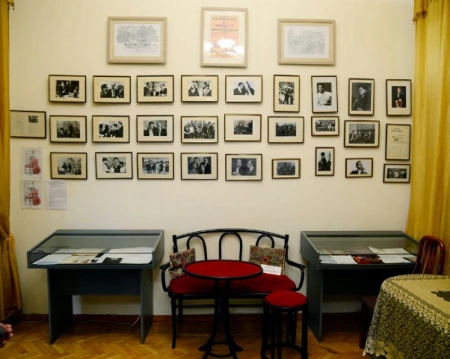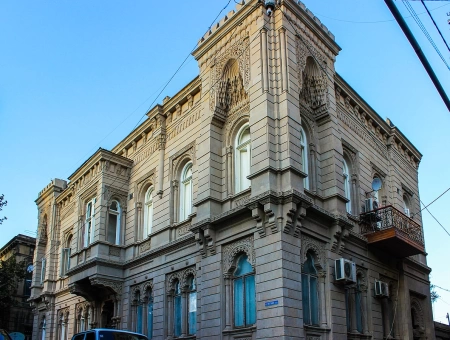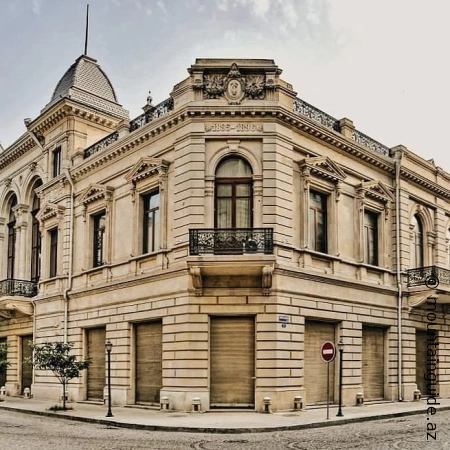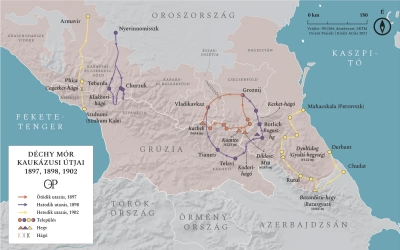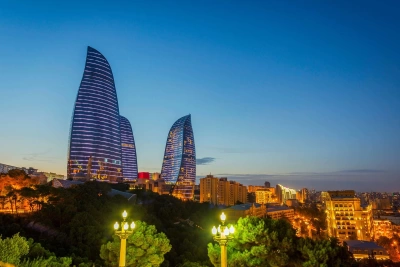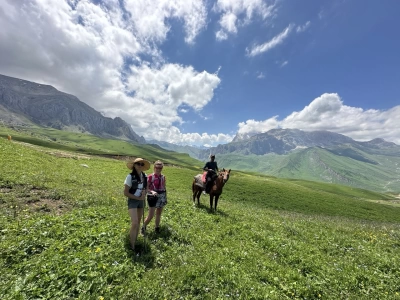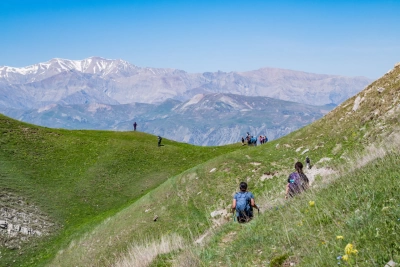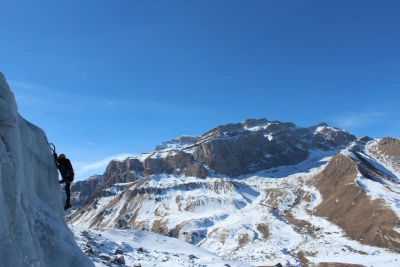In the mountainous paths of the Caucasus, in the tranquil regions of Azerbaijan, the stories of the Poles, who were once exiled but left their mark, are hidden. The bridges, schools, and houses they built silently preserve the traces of the past to this day.
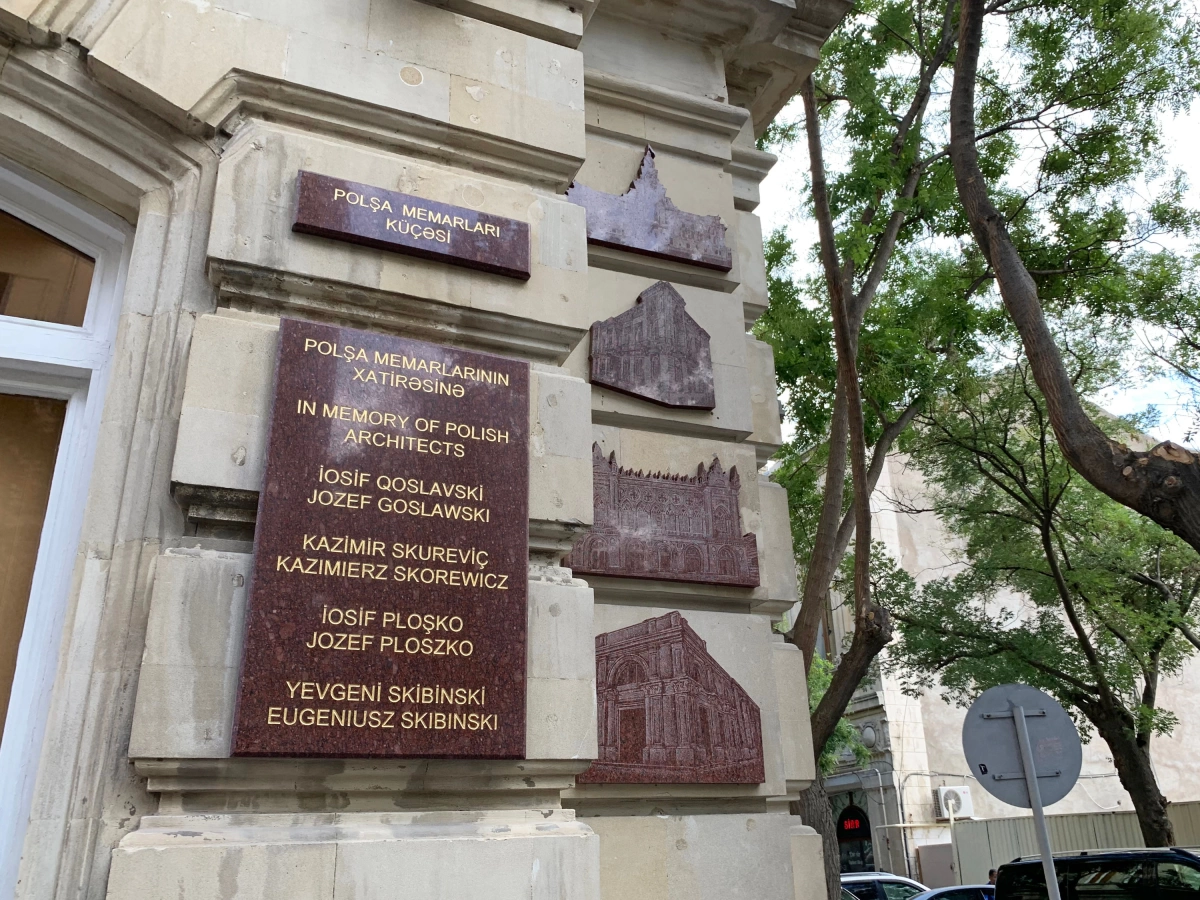
Modern Baku was shaped by the famous Oil Boom of the late 19th and early 20th centuries, which transformed the city into a cosmopolitan center combining both Western and Eastern influences. At the forefront of this magnificent transformation were a group of Polish architects who, along with other Poles, left behind an incredible legacy.
In the late 19th century, Baku was a city undergoing significant changes. The great development in the oil industry – by 1901, Baku produced more than half of the world’s oil – brought new wealth, which led to major urban development and rapid population growth. In just a few decades, the city transformed from a provincial settlement of the Russian Empire into the “Paris of the Caucasus.”
During this period, Baku witnessed the Polish architectural phenomenon, with the urban transformation being managed by three Polish-born chief architects: Józef Gosławski (1892-1904), Kazimierz Skorewicz (1904-1907), and Józef Ploszko (1907-1910). Additionally, Yevgeny Skibinski, who worked in the architecture department of the Baku City Council, was also involved in these works. These Polish architects also designed magnificent fin-de-siècle buildings.
Since both Poland and Azerbaijan were part of the Russian Empire at that time, many Poles, among the economic migrants who came to Baku to take advantage of the opportunities created by the Oil Boom, played significant roles. Along with architects, engineers, scientists, musicians, doctors, and teachers were among these migrants. Some Poles, who had been deported to the Caucasus for participating in uprisings against the Russian Empire, also lived in the city. While the Polish community played an important role in the oil industry and other sectors, their greatest legacy remains in the field of architecture.
The Polish architects featured in this brochure designed stunning mansions and palaces built for the oil elite of Baku, as well as exquisite public buildings and cathedrals. Their iconic designs, combining the best of local and Western architectural traditions, remain some of Baku’s most beautiful monuments even a century later. However, the Oil Boom period was not solely defined by the Polish phenomenon, as many other local and foreign architects also participated in these works, reflecting the growing interest of Azerbaijanis in European culture at the time. This trend reached its peak with the establishment of the first parliamentary republic in the Muslim world in Azerbaijan in 1918.
The contribution of Polish architects extended to other regions of Azerbaijan as well. For instance, architect Józef Ploszko oversaw the restoration of the Juma Mosque in Shamakhi after the earthquake. In Yelizavetpol (now Ganja), chief architect Ignacy Krzystalowicz designed the city plan and several buildings. Catholic churches built by exiled Polish soldiers can still be found in Qusar and Zaqatala.
The outbreak of World War I, along with the major changes brought about by the Bolshevik Revolution in 1917, led most of the Polish migrants to leave Baku, marking the end of this remarkable Polish influence in Azerbaijan. However, several hundred descendants of those who arrived in the 19th century still live here today.
In the following pages, we present the architectural masterpieces of four prominent Polish architects, as well as a few locations bearing Polish heritage.
Polish Architects
Here, we present four prominent Polish architects who helped create Baku's unique appearance and atmosphere during the Oil Boom period. Each of them spent their most productive years in the city, designing astonishing buildings that continue to delight both locals and visitors.
Józef Gosławski (1865–1904)
He was nicknamed “Caucasian Rastrelli” due to his successful work on the construction of the Alexander Nevsky Cathedral.

This project brought Gosławski to Baku after graduating from the Saint Petersburg Civil Engineering Institute. He spent the remainder of his short life in the city, and he lived at 31
Mirza Ibrahimov Street, which is now commemorated with a plaque (map 1). Gosławski
worked with the oil magnate Z...
He had become the beloved architect of Eynalabdin Tağıyev and had designed the Tağıyev
Palace and the Muslim Girls' School for him. In 1892, at the age of 27, he was appointed
Chief Architect of Baku and worked in this position until his untimely death in 1904. He was famously hardworking, which led to his deteriorating health. His last project was the Baku City Duma (local government body), and he passed away at the age of 38 from tuberculosis while working on this project. After his death, his sister Mixalina and his young daughter Lusiya stayed in Baku and took possession of his belongings. Lusiya took these belongings with her when she moved to Leningrad in the 1930s, but during the Siege of Leningrad in World War II, the collection was completely lost.
Kazimierz Skórzewicz (1866–1950)
 He was another architect who graduated from the Saint Petersburg Institute of Civil Engineers and came to Baku at the invitation of Jozef Goslavski. Skórzewicz’s buildings usually reflected a fusion of Western and Eastern styles. He designed several residential buildings in line with the architectural ensemble of the Inner City, as well as the building that currently houses the Office of the Prosecutor General of the Republic of Azerbaijan and the building known as the Tağıyev Passage (now the Tağıyev Shopping Center). Skórzewicz worked in Baku for 12 years (he was also the city's chief architect from 1904 to 1907) and left the city after the 1905 Russian Revolution, returning to his native Poland. There, he designed the building of the Polish Sejm (lower house of parliament) in Warsaw.
He was another architect who graduated from the Saint Petersburg Institute of Civil Engineers and came to Baku at the invitation of Jozef Goslavski. Skórzewicz’s buildings usually reflected a fusion of Western and Eastern styles. He designed several residential buildings in line with the architectural ensemble of the Inner City, as well as the building that currently houses the Office of the Prosecutor General of the Republic of Azerbaijan and the building known as the Tağıyev Passage (now the Tağıyev Shopping Center). Skórzewicz worked in Baku for 12 years (he was also the city's chief architect from 1904 to 1907) and left the city after the 1905 Russian Revolution, returning to his native Poland. There, he designed the building of the Polish Sejm (lower house of parliament) in Warsaw.
Józef Płoszko (1867–1931)
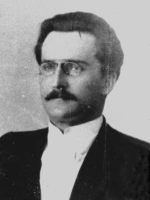 After graduating from the Saint Petersburg Institute of Civil Engineering, Józef Płoszko came to Baku at the invitation of Jozef Goslavski and began working at the Baku City Administration's Construction Department. Płoszko became the favorite architect of the oil magnates Musa Nagıyev and Murtuza Muxtarov. He designed the Ismailiyya Palace for Musa Nagıyev and the "Palace of Happiness" (now the Marriage House) for Murtuza Muxtarov. Other notable buildings he designed include the State Puppet Theater, the former Baku Virgin Mary Catholic
After graduating from the Saint Petersburg Institute of Civil Engineering, Józef Płoszko came to Baku at the invitation of Jozef Goslavski and began working at the Baku City Administration's Construction Department. Płoszko became the favorite architect of the oil magnates Musa Nagıyev and Murtuza Muxtarov. He designed the Ismailiyya Palace for Musa Nagıyev and the "Palace of Happiness" (now the Marriage House) for Murtuza Muxtarov. Other notable buildings he designed include the State Puppet Theater, the former Baku Virgin Mary Catholic
Church, and the building that now houses the “Lukoil” company. Płoszko also participated in the reconstruction of the Juma Mosque in Shamakhi after the earthquake. He designed buildings in various styles, but he primarily favored Gothic and Art Nouveau styles. Płoszko worked in Baku for more than 30 years and served as the city's chief architect from 1907 to 1910. In 1925, he moved to Warsaw.
Eugeniusz Skibiński (1858–1918)
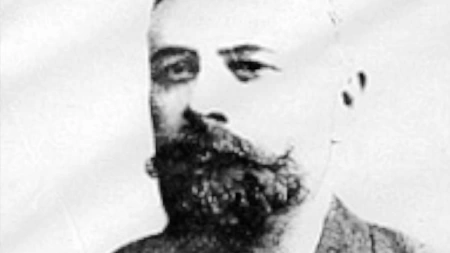 He was the only one of four Polish-born Azerbaijani architects
He was the only one of four Polish-born Azerbaijani architects
to be born in Azerbaijan – in Shamakhi. A graduate of the St.
Petersburg Academy of Fine Arts, Skibiński designed over 250
buildings in Baku. One of his most famous works is the building
that now houses the Union of Architects (formerly known as
the Agabala Guliyev House). The rich decorative elements of this building were inspired by the Shirvanshahs' Palace. Skibiński also participated in the design of the Baku Railway Station. His style is noticeably rich with Eastern influences, reflecting his admiration for the medieval architecture of Absheron. However, what truly distinguished his buildings was how the architectural traditions of the Old City were successfully and harmoniously adapted to the new Baku that emerged during the oil boom.
Polish Heritage in Azerbaijan's Regions
At the end of the 19th and beginning of the 20th century, Polish heritage in Azerbaijan: the activity of Polish architects, engineers, and military personnel in Azerbaijan extended beyond the boundaries of Baku. Their traces can also be found in other regions such as Shamakhi, Ganja, Qusar, and Zagatala.
Shamakhi
After the devastating earthquake in 1902, Polish architect Józef Płoszko participated in the restoration of the Shamakhi Juma Mosque, the oldest mosque in Azerbaijan. The mosque was built in 743, making it one of the oldest mosques in the Caucasus. Unfortunately, due to financial difficulties, the reconstruction could only be partially completed.
Ganja
In the late 19th century, Ignacy Krzysztalowicz served as the chief architect of the city of Ganja (then called Yelizavetpol). In 1873, he prepared the first master plan for the city and designed many residential buildings for wealthy residents. These efforts had a significant impact on the modernization of Ganja’s urban development.
Qusar and Zagatala
Polish soldiers and officers serving in the Russian military garrisons in these cities participated in the construction of Catholic churches. These churches were built not only to meet religious needs but also to preserve the cultural and spiritual heritage of the Polish community. They remain rare examples of religious architecture that carry traces of the Polish community in these regions.
Location of Monuments on the Map of Baku
A Journey Through History on Independence Street
Baku City Executive Power
The Baku City Executive Power building was constructed between 1900-1904 based on the design of Polish architect Józef Gosławsk. This was Gosławski's final project, but he could not complete it due to dying of tuberculosis during the construction process. His colleagues, Polish architects Kazimierz Skorewicz and Józef Ploszko, continued the construction.
They remained faithful to Gosławski's original plans. The luxurious yet modest building, constructed in the Baroque style, symbolizes the responsibility of the City Executive Power for the city's development, the improvement of residents' living standards, and the prosperity of Baku. Red bricks, specially imported from Italy, were used for the outer facades. The second-floor porticos feature various coats of arms symbolizing the different activities of the Baku City Executive Power. Additionally, the city's emblem – three flaming tongues – is displayed here, and a melody plays from the clock tower in the square every hour. Although the year "1870" is written on the facade, it does not refer to the construction date, but to the year the new municipal laws were adopted in the Russian Empire. Today, the Baku City Executive Power offices are located here.
Manuscripts Institute
This magnificent building was designed in the national Romantic style by Polish architect Józef Gosławski between 1898-1901. Its owner, the influential oil baron and philanthropist Haji Zeynalabdin Taghiyev, sought to establish the first secular girls' school in the Muslim East. This project was difficult for Gosławski, as it was necessary to combine both Eastern style and modesty with a sense of austerity.
The design emphasized simplicity and harmony, as in the late 19th and early 20th centuries, despite the influence of European culture in the Russian Empire, strict Islamic laws still prevailed. Education was mainly provided for young men, while girls were considered not to need it. During the construction of the institution, Taghiyev faced a double challenge: Tsar's refusal and opposition from local clergy. He managed to solve both problems: he resolved the first by obtaining the permission of Empress Alexandra Fyodorovna to name the school after her, and the second by collecting letters of approval from prominent Islamic religious leaders. The school opened in 1901 and accepted girls from both wealthy and poor families. The curriculum included reading, writing, mathematics, household management, handicrafts, and etiquette.
The building's interior design, by Gosławski, took into account all the needs of the school, including prayer and laundry rooms, a medical room, a library, and more. Later, in 1913, the building was transformed into a teachers' seminary for Muslim girls. From December 7, 1918, until the Soviet invasion in April 1920, it housed the first parliament of the Azerbaijan Republic. Today, the building hosts the Azerbaijan Manuscripts Institute, and the home museum of the famous poet Huseyn Javid, who lived here from 1920-1937. The Manuscripts Institute is open to visitors, and it features a unique museum, which was once the place where the first parliament of the Azerbaijan Republic met.
The Presidium of the Azerbaijan National Academy of Sciences
(Ismailiyya Palace)
Located in the center of Baku, this magnificent building, known as a piece of Italy, is said to be inspired by the Palazzo Ducale in Venice. Built between 1908-1913, it was designed by Polish architect Józef Ploszko and funded by fabulously wealthy oil baron Aga Musa Nagayev. The story behind the building goes like this:
In 1905, the headquarters of the Muslim Charity Society was supposed to be built, and a vacant plot of land next to Taghiyev's Muslim Girls' School (now the Manuscripts Institute) was selected for this purpose. However, the construction process was delayed due to difficulties in finding financial support. This problem was solved when Baku's oil millionaires presented the project to Aga Musa Nagayev during the Novruz festival. The goal was to build a building in memory of his son Ismail, who had died at a young age from tuberculosis. Nagayev agreed and gave the task of designing the building to Ploszko. This became Ploszko's first independent project in his 30 years in Baku and remains one of his most iconic works. According to the legend, Nagayev sent Ploszko on a long trip to Europe, and the result was this Venetian Gothic masterpiece. During the March Days of 1918, when thousands of Azerbaijanis were killed by Bolshevik and Armenian extremist forces and large-scale civil unrest occurred, the building was almost completely destroyed. Later, during the Soviet regime, it was saved from complete destruction by protests from the local population. Today, the building is considered one of the main architectural landmarks of Baku, and it houses the Presidium of the Azerbaijan National Academy of Sciences.
Murtuza Mukhtarov Street
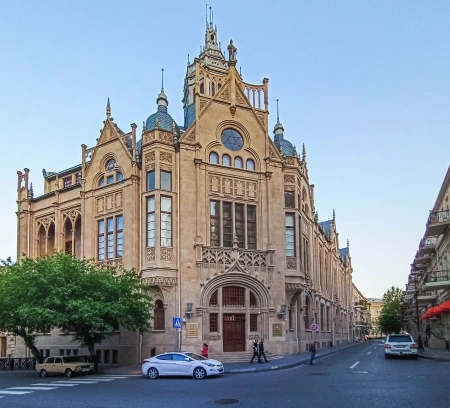 The Seadet Palace, considered one of the best buildings of the oil boom era, was designed by Polish architect Józef Ploszko and constructed between 1911-1912 in French Gothic style. Previously known as Mukhtarov Palace, it was built by oil baron Murtuza Mukhtarov as a gift for his beloved wife, Liza Tuganova, the daughter of a Russian general from Ossetia. According to the legend, Liza fell in love with a Gothic building in Venice during her travels in Europe and expressed her admiration for the owner. After returning to Baku, Mukhtarov asked Ploszko to design a similar building. The construction of the palace took nine months, and after completion, Mukhtarov surprised Liza by revealing the new home to her in a carriage. However, the story has a tragic end: In April 1920, when the Bolsheviks came to power in Baku, it is said that Mukhtarov shot Red Army soldiers who attempted to seize his property and then turned the weapon on himself.
The Seadet Palace, considered one of the best buildings of the oil boom era, was designed by Polish architect Józef Ploszko and constructed between 1911-1912 in French Gothic style. Previously known as Mukhtarov Palace, it was built by oil baron Murtuza Mukhtarov as a gift for his beloved wife, Liza Tuganova, the daughter of a Russian general from Ossetia. According to the legend, Liza fell in love with a Gothic building in Venice during her travels in Europe and expressed her admiration for the owner. After returning to Baku, Mukhtarov asked Ploszko to design a similar building. The construction of the palace took nine months, and after completion, Mukhtarov surprised Liza by revealing the new home to her in a carriage. However, the story has a tragic end: In April 1920, when the Bolsheviks came to power in Baku, it is said that Mukhtarov shot Red Army soldiers who attempted to seize his property and then turned the weapon on himself.
State Prosecutor's Office
This building was previously the Rothschild family office in Baku and is now used by the State Prosecutor's Office. It was constructed in the neo-Gothic style between 1897 and 1899 and carries typical features of Baku architecture – white stone tiles on the façade, which is a style commonly used by the building’s architect, the Polish architect Kazimierz Skorewicz.
The Rothschilds played a significant role in the city's development, as they were among the most important foreign representatives of the oil industry, and their wealth helped boost the rapid growth of this industry. However, the Rothschilds were also known for their charitable projects: they acted as trustees for educational institutions and provided free education to children of oil workers. Their office also housed a subsidiary company called Mazut, associated with the Caspian-Black Sea Oil Industry and Trade Company, which was involved in oil production along the Bibi-Heybat coast. In the 1930s, due to the presence of the Central Peasants Workers' House, the architecture underwent several modifications, with “decorative” and “inappropriate for the working class” elements removed.
Rostropovich House Museum
Another talented person of Polish origin, Mstislav Rostropovich, left a mark on Azerbaijan's history and culture, and is recognized as one of the greatest cellists of all time. He was born in Baku in 1927,
where his parents had come two years earlier at the invitation of the founder of modern classical music in Azerbaijan, composer Üzeyir Hacıbəyov, to teach at the Azerbaijan State Conservatory. His father, Leopold, was a renowned cellist and conductor, and his mother, Sofia, was a specialist pianist.
Influenced strongly by this musical environment, young Mstislav studied at the Gnessin State Music College, then went to the Orenburg Music School, and later continued his education at the Orenburg State Institute of Arts. Throughout his remarkable career, he performed nearly the entire cello music repertoire, and many works were written specifically for him.
Today, in the house where the Rostropovich family lived in Baku, a museum displays over 5,000 items reflecting their life. They loved Baku dearly but left the city in 1931. In 1974, Mstislav and his family (including musicians) moved to the USA to escape the pressures for supporting dissidents such as writer Aleksandr Solzhenitsyn during the Soviet regime.
In Baku, there is also a music school named after the Rostropovich family, and every year, the Rostropovich International Music Festival held in March-April attracts musicians from around the world.
Union of Architects
Previously known as the Aghabala Guliyev House, this building represents the pinnacle of the career of Polish architect Eugeniusz Skibinski in Baku. The building’s magnificent exterior design is inspired by the Shirvanshahs' Palace in the Old City. The owner of the house, Aghabala Guliyev, came from a poor family but was evidently a talented entrepreneur: as a child, he earned money by selling his mother's qutab. Later, he became wealthy in the flour trade and was known as the “King of Flour in Baku,” which allowed him to buy a flour mill, a grain-cleaning factory, and oil fields.There is an interesting scandalous story about Aghabala Guliyev: at the age of 27, he fell in love with a girl and proposed to her, but was rejected by her family. This led him to attempt to abduct her (a common practice in the Caucasus at the time), but he failed and was sentenced to two months in prison instead of a wedding ceremony.
Aghabala Guliyev's house was built in 1899 on the former Fars Street and today houses the National Union of Architects. The building is in the Romantic-Oriental style, and in addition to its striking exterior features, it has an elegant interior richly decorated with Moorish mosaics and colorful wall paintings.
Cooperative Union
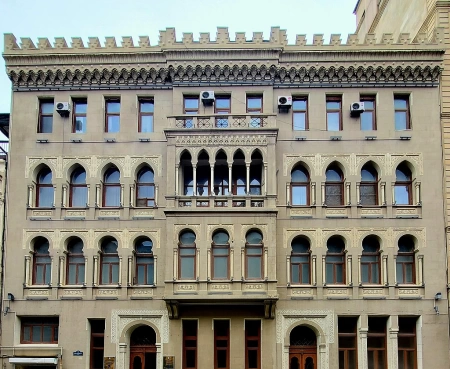 Located on the former Staropolitseyskaya Street, this four-story building belonged to the Polish-origin wealthy oil producers, the Rylski family. The building was constructed in 1912 and designed by Polish architect Yozef Ploszko. Ploszko's mastery of local Azerbaijani architectural traditions is clearly reflected in the building's magnificent Eastern façade. In 1919, the Rylski family's mansion was converted into the location of the Polish Consulate in Baku. Today, the building hosts the Cooperative Union.
Located on the former Staropolitseyskaya Street, this four-story building belonged to the Polish-origin wealthy oil producers, the Rylski family. The building was constructed in 1912 and designed by Polish architect Yozef Ploszko. Ploszko's mastery of local Azerbaijani architectural traditions is clearly reflected in the building's magnificent Eastern façade. In 1919, the Rylski family's mansion was converted into the location of the Polish Consulate in Baku. Today, the building hosts the Cooperative Union.
Azerbaijan History Museum
The building of the Azerbaijan History Museum, located on the former Gorchakovskaya Street, was built between 1895-1901 as the family home of the legendary oil baron Haji Zeynalabdin Tağıyev. The
immortalizes their names and presents photos of some of the masterpieces they created in the city: Palace of Happiness, Presidium of the Academy of Sciences (former Ismailiyya Palace), Baku City Executive Power, and the Union of Architects (former Aghabala Guliyev House). The plaque was created by Azerbaijani sculptor Elbay Qasimov. This street is located near Sahil metro station, was officially opened on May 31, 2019, and intersects with Tarlan Aliyev and Haji Zeynalabdin Taghiyev streets.
Baku Shopping Center
Located on former Olginski Street, now known as Taghiyev Passage and today as Baku Shopping Center, it was built in 1896 and designed by Polish architect Kazimierz Skórewicz. This building, currently housing several cafés and restaurants, was once the largest shopping center in Baku. In 1903, it was purchased by famous oil baron Haji Zeynalabdin Taghiyev and became known as Taghiyev Passage. People came here to buy hats, shoes, shirts, fabrics, and more, and to watch movies in one of the first cinemas in Baku, where Boris Svetlov's "In the Realm of Oil and Millions" (1915), the first Azerbaijani film, was shown. Although the interior of Taghiyev Passage is quieter today, several jewelry and antique shops still operate here. Walking through this place allows one to admire classic architecture and imagine the special atmosphere of pre-revolutionary Baku.
Residential Building on Safarli Street
 Located on the former Vorontsov Street, this three-story residential building was the first in Baku built in Gothic style and belonged to the Malikov family. It was designed by Polish architect Józef Gosławski between 1893–1897 and its façade is said to have been inspired by Florentine palaces. The house is also notable for its numerous windows, allowing abundant natural light inside.
Located on the former Vorontsov Street, this three-story residential building was the first in Baku built in Gothic style and belonged to the Malikov family. It was designed by Polish architect Józef Gosławski between 1893–1897 and its façade is said to have been inspired by Florentine palaces. The house is also notable for its numerous windows, allowing abundant natural light inside.
Azerbaijan State Puppet Theatre
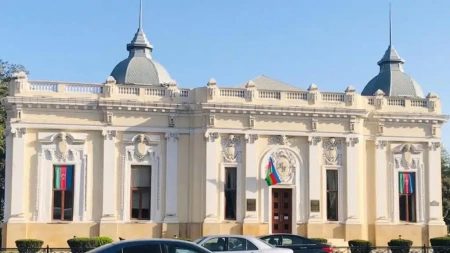 This small fin-de-siècle building was designed and constructed in French Renaissance style by Polish architect Józef Płoszko between 1908–1910. Initially functioning as the Phenomenon Cinema, it was Baku’s first cinema. It showcased silent films and was known for its innovative ventilation system that changed the air every 15 minutes. Architect Shamil Fatullayev notes that the building also housed a small casino, partly owned by Płoszko himself, where he spent considerable time. A decade later, the building was rebuilt and turned into the Satiragit (Satire-Agitation) Workers' Theatre. During the Soviet era, it housed the Museum of Agriculture Academy and later became the Azerbaijan State Puppet Theatre.
This small fin-de-siècle building was designed and constructed in French Renaissance style by Polish architect Józef Płoszko between 1908–1910. Initially functioning as the Phenomenon Cinema, it was Baku’s first cinema. It showcased silent films and was known for its innovative ventilation system that changed the air every 15 minutes. Architect Shamil Fatullayev notes that the building also housed a small casino, partly owned by Płoszko himself, where he spent considerable time. A decade later, the building was rebuilt and turned into the Satiragit (Satire-Agitation) Workers' Theatre. During the Soviet era, it housed the Museum of Agriculture Academy and later became the Azerbaijan State Puppet Theatre.
This elegant building was one of the first architectural monuments on the newly constructed Baku Boulevard and encouraged city officials to further beautify the boulevard. Today, performances in the Puppet Theatre are mainly in Azerbaijani and Russian, but are easily understandable regardless of language and worth watching.
Grave of Engineer Pavel Pototski
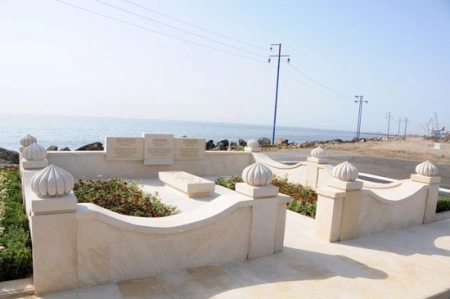 Another Polish engineer from Baku with a remarkable story was Pavel Pototski. He graduated from the Technical Institute in 1901 and worked in many European countries, including the Netherlands and Russia. Later, he came to Baku upon the invitation of the famous Polish geologist Witold Zglenicki. Zglenicki, known as a pioneer in offshore oil extraction and for his philanthropy, often referred to as the "Polish Nobel," proposed an innovative project for extracting oil by reclaiming land from the sea in the Bibi-Heybat Bay. However, he passed away before realizing the project.
Another Polish engineer from Baku with a remarkable story was Pavel Pototski. He graduated from the Technical Institute in 1901 and worked in many European countries, including the Netherlands and Russia. Later, he came to Baku upon the invitation of the famous Polish geologist Witold Zglenicki. Zglenicki, known as a pioneer in offshore oil extraction and for his philanthropy, often referred to as the "Polish Nobel," proposed an innovative project for extracting oil by reclaiming land from the sea in the Bibi-Heybat Bay. However, he passed away before realizing the project.
This project, the first of its kind in the world, was eventually completed 20 years later by Pototski, becoming the project of his life. In 1919, Pototski began to lose his sight and eventually became completely blind. Nevertheless, he continued working on the project due to his deep knowledge of the area and its features. In total, 79 hectares of land were reclaimed under his supervision. On April 18, 1923, an oil well 82.5 meters deep was put into operation on the reclaimed land, garnering worldwide attention.
Pototski considered the Bibi-Heybat project so important that he requested to be buried there. Today, his monument in Bibi-Heybat is a must-visit for those interested in Polish heritage and Azerbaijan’s oil history.
Baku Railway Station
A notable example of Eastern architecture, the historic building of the Baku Railway Station was built in 1883 during the construction of the railway between Baku and Tbilisi, the capital of Georgia. Among the various artists and architects involved in the project was Polish architect Eugeniusz Skibinski. In addition to its impressive exterior, the station building was famous in its time for its richly decorated interiors featuring wall paintings reminiscent of Eastern carpets, mosaic flooring, and various sculptural details.
 There were beautifully designed waiting rooms and a large vestibule with grand staircases. Built in a part of the city that served as a junction between the city center and the Absheron Peninsula, the station's construction on a garden plot marked the beginning of large-scale urban development in the area. Today, the station is a combination of old and new buildings and features escalators, Wi-Fi, shops, cafés, and restaurants. You can take a high-speed train from here to Ganja, a city with a rich history, a vibrant youth culture, and ...
There were beautifully designed waiting rooms and a large vestibule with grand staircases. Built in a part of the city that served as a junction between the city center and the Absheron Peninsula, the station's construction on a garden plot marked the beginning of large-scale urban development in the area. Today, the station is a combination of old and new buildings and features escalators, Wi-Fi, shops, cafés, and restaurants. You can take a high-speed train from here to Ganja, a city with a rich history, a vibrant youth culture, and ...
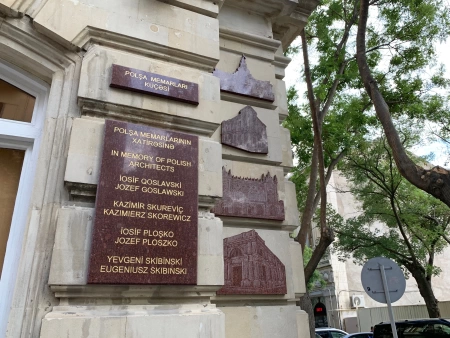
Immortalizing their names and showcasing masterpieces they created in the city — Palace of Happiness, Presidium of the Academy of Sciences (formerly Ismailiyya Palace), Baku City Executive Power, and the Union of Architects (formerly Aghabala Guliyev House). This commemorative plaque was created by Azerbaijani sculptor Elbay Qasimov. The street, located near Sahil metro station and intersecting with Tarlan Aliyev and Haji Zeynalabdin Taghiyev streets, was officially opened on May 31, 2019.
Baku Shopping Center
Formerly Olginski Street, now known as Taghiyev Passage and currently home to the Baku Shopping Center, this building was designed by Polish architect Kazimierz Skórewicz in 1896. Once Baku’s largest shopping center, it was purchased in 1903 by oil baron Haji Zeynalabdin Taghiyev and renamed after him. It housed stores selling hats, shoes, and fabrics, and one of Baku’s first cinemas. Today, it features cafés, restaurants, and antique shops, with its architecture preserving the charm of pre-revolutionary Baku.
Residential Building on Safarli Street

Located on former Vorontsov Street, this Gothic-style building was constructed between 1893–1897 for the Malikov family. Designed by Polish architect Józef Gosławski, its façade was inspired by Florentine palaces. Notably, its design includes numerous windows allowing natural light to flood the interior.
Azerbaijan State Puppet Theatre

Designed in French Renaissance style by Polish architect Józef Płoszko, this elegant building was originally the Phenomenon Cinema, Baku’s first cinema. Built between 1908–1910, it featured an advanced ventilation system and even a small casino. Over the decades, it served different roles before becoming the Puppet Theatre, now offering performances accessible even to non-Azerbaijani speakers.
Grave of Engineer Pavel Pototski

Pavel Pototski, a Polish engineer who arrived in Baku at the invitation of Witold Zglenicki, played a vital role in completing the world’s first offshore oil extraction project in Bibi-Heybat Bay. Despite going blind, Pototski supervised the reclamation of 79 hectares of land, where an oil well was drilled in 1923. His grave, located in Bibi-Heybat, is a key site linking Polish heritage and Azerbaijan’s oil history.
Baku Railway Station

Opened in 1883 as part of the Baku-Tbilisi railway, the station building was designed by Polish architect Eugeniusz Skibinski. Known for its Eastern-inspired architecture, mosaic flooring, and vibrant wall paintings, it played a central role in connecting Baku to the Absheron Peninsula. The modernized station today combines old-world elegance with modern amenities including shops, cafés, and Wi-Fi.
Church of the Immaculate Virgin Mary
The Church of the Immaculate Virgin Mary was a striking neo-Gothic building primarily serving Baku’s Polish community. It was designed by Polish architect Józef Płoszko and financed in 1912 by the Rylski family, Polish oil magnates in Baku. Unfortunately, it was later demolished by the Soviet authorities as part of their anti-religious campaign, and a cultural center used by the KGB was built in its place. This large Soviet structure now functions as the Shakhriyar Cultural Center.
However, after Azerbaijan regained independence, freedom of worship was restored to all religious communities, including Catholics, and a plot of land was allocated for the construction of a new Catholic church (in a different part of the city).
The site for the new church was consecrated in 2003 by Cardinal Jean-Louis Tauran, head of the Vatican delegation visiting Azerbaijan, in accordance with the tradition of the Roman Catholic Church. A year later, Cardinal Crescenzio Sepe officially blessed the church's foundation, and the construction was completed in 2007. The church was jointly designed by Professor Paolo Ruggiero of the Naples University of Architecture and Baku’s Chief Architect Akif Abdullayev, and it can accommodate 250–300 people. The official opening took place in March 2008 during the visit of Cardinal Tarcisio Bertone, the Secretary of State of the Vatican. Interestingly, the church bells were a gift from then-President of Poland, Lech Kaczyński.
Source: https://www.tourismboard.az/publication/660/22



